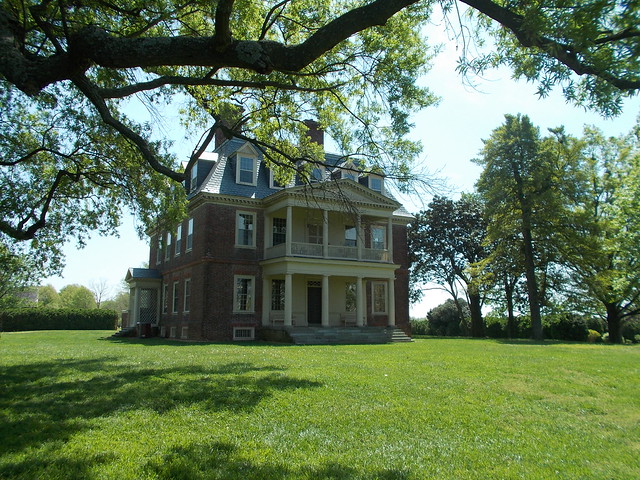Now that I have been living in Virginia for 10 months (the time has certainly flown by!), I have finally started traveling a bit outside of my new hometown to explore the amazing and extensive history that the Commonwealth has to offer. I'm grateful to have a new friend to explore with and we have a long list of sites and museums to visit. We decided to start with some of the beautiful plantation homes situated along the James River.
Shirley Plantation
April 2013
The first house we traveled to was
Shirley Plantation, which is located in Charles City, Virginia. It was a lovely drive on the property to reach the entrance of the home; the path brought us down a very long dirt road, with large fields stretched out on all sides. Finally, rows of trees appeared on either side of the road with the main house visable straight ahead. Once we secured our tickets, we waited by the front steps for the guided tour to begin. Our guide was very knowledgeable about the house and showed a great understanding of the Hill Carter family lineage. Portraits and photos around the house led us through the story of the family, while furnishings and trinkets provided us with a connection to several family members and their personal stories.
The tree lined drive leading to Shirley Plantation.
April 2013
In 1613, Sir Thomas West, Baron de la Warr, named his new property Sherley Hundred after his wife, Lady Cessalye Sherley. Interestingly, Lady Cessalye never stepped foot in the New World and her husband would only own the property for a few years. In 1638, Captain Edward Hill bought the property and soon after built a home on the land, where he grew tobacco, among other crops. When his only son died at an early age, Edward Hill III passed the property to his youngest daughter Elizabeth, and therefore also to her husband, John Carter, the eldest son of Robert "King" Carter. The first dwelling was taken down to make room for their large brick home, which was finished in 1738 and still stands today.
The back view of the main house, from the river front.
Shirley Plantation, April 2013
The Hill Carter family was intertwined further with other renowned families in our nation's history, and over the years both the family and the property went through trials and triumphs. One of my favorite stories from the tour is a tale of the bravery and kindness of the women of the house during the Civil War. In May of 1861, wounded Union soldiers were brought to Shirley and the surrounding plantation properties. The Carter women worked tirelessly to nurse the soldiers and in return General McClellan issued a safeguard, protecting the home from any future harm.
A view of the ice house from inside the store house.
Shirley Plantation, April 2013
Shirley opened to the public in the mid twentieth century. Today, the eleventh generation of the family lives in the house and directs the new Shirley Plantation LLC. Over the past decade, extensive restoration projects have ensured the continued existence of a remarkable home and an inspiring family story.
After the tour, we strolled the grounds, took in the view of the river from the back vista, explored the original outbuildings, and stopped for a while in the gift shop. The staff (as well as the animals!) at Shirley were all extremely friendly and welcoming, which only added to this wonderful experience. Be sure to visit
www.ShirleyPlantation.com to learn more about Shirley Plantation, and to make plans for your own visit. For more photos from my visit, please see the
set on Flickr.





3 comments:
Hello! Your post was wonderful. I remember Shirley Plantation from this past Spring when I visited it while on a band trip. I'm glad to see other people enjoy it as much as I did.
I wanted to visit Shirley Plantation the last time I was in Virginia but didn't have the time. Too many things to see and do in Virginia!
-Emily
That sounds very fascinating! Just wondering: if this was a plantation and they grew tobacco in the past, does this plantation also have a history with slavery involved?
Post a Comment